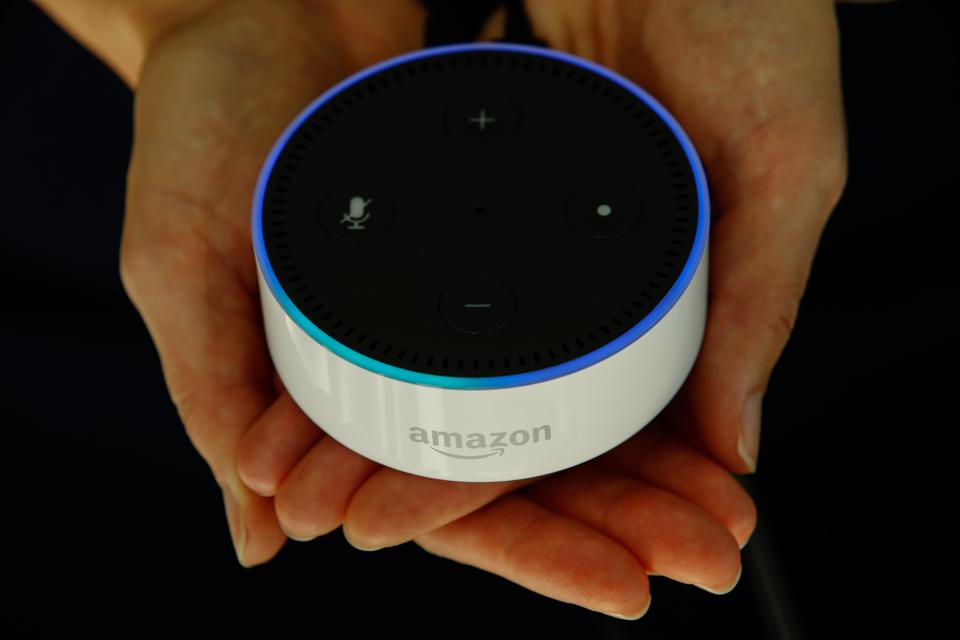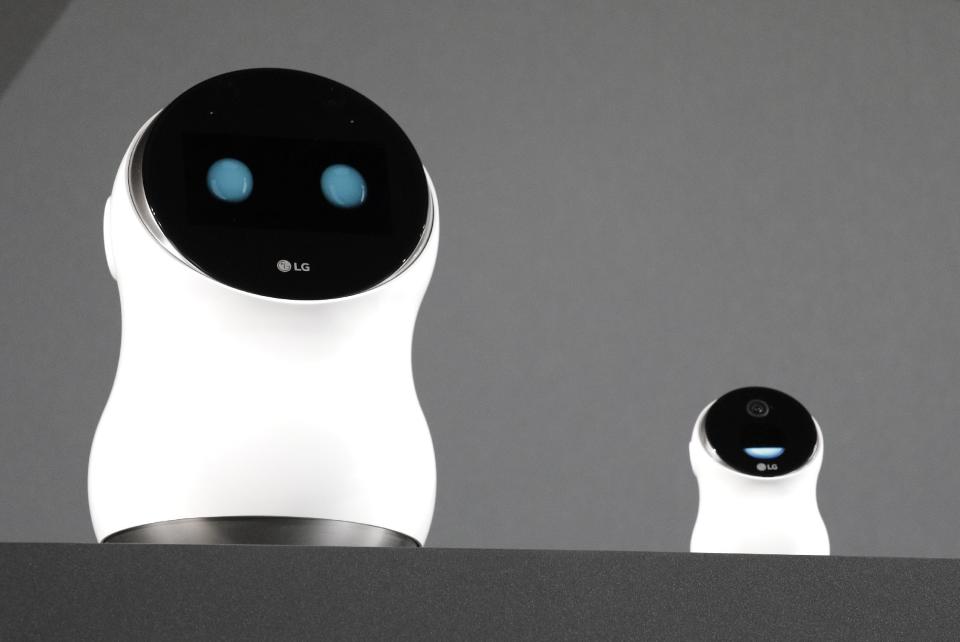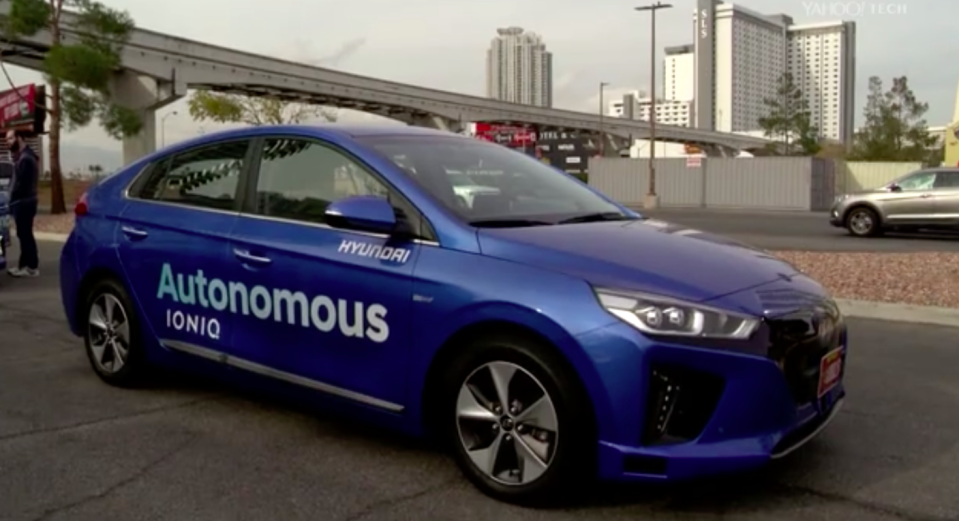David Pogue's CES roundup: All you have to remember is one word
The Consumer Electronics Show is the biggest trade show in the Western Hemisphere. If you somehow missed the show this past week—you’re so lucky!
CES a staggeringly huge, crowded, noisy, sensory-overload sort of show. About 3,900 booths fill enough floor space for 35 football fields. Trying to take it all in gets exhausting and expensive.
(It’s even worse if you work for one of the exhibitors; because CES falls at the beginning of January every year, your holidays are neatly ruined every single year.)
Everybody always asks: “What’d you see at CES this year?”
To which I now have a handy answer: an acronym. ARCHIVE.
That stands for Alexa, Robotics, Cars, Health wearables, Internet of Things, VR—and Everything Else.
Alexa Everywhere

The Amazon (AMZN) Echo is that black cylinder that sits in your house and responds to voice commands, kind of like Siri for the home. (Here’s my review.) But as though its invention weren’t brilliant enough, Amazon has now persuaded the world that its technology (and its voice character, named Alexa) should be the standard voice-response technology for every appliance on earth.
At CES, we saw Amazon’s Alexa built into refrigerators (LG and Samsung), light switches (Incipio), power strips (Incipio, iDevices, Belkin), lamps (GE), speakers (Omaker), robotic vacuums (Samsung), satellite boxes (Dish), robots (Ubtech, Hubble), TVs (Seiki, Westinghouse, Element), headphones (Sensory), security cameras (Somfy), door locks (ADT), air purifiers (Coway), washers and dryers (Whirlpool), showerheads (Hydrao), cars (Ford), and on and on.
It’s an overwhelming list. It leaves Amazon’s rivals in the dust, staring at their feet and wondering what went wrong.
You know what? Alexa is going to be what saves the Internet of Things.
That, of course, is the annoying name for devices that we can control by pulling out our phones, unlocking them, and opening an app. (Yes, that’s what you have to do just to turn on an IoT lightbulb.) It’s too much hassle, and there are too many complicated, competing apps, for that approach ever to work.
But just talking to your room? “Alexa, is the dryer done yet?” “Alexa, make it two degrees warmer in here.” “Alexa, lock the doors.” “Alexa, I want to watch ‘Rambo.’”… Now that, the masses will love. And master easily.
Sorry, Apple, Google, Microsoft, and Samsung. This time, Amazon wins.
Robotics

There were home robots on display at CES—like the Amazon Echo with faces and bodies. There were vacuum robots and lawn-mowing robots. LG displayed a human-height robot designed for airports: You show it your boarding pass, and it offers to “walk” with you to the gate.
But robotics is the key to far more than actual robotics. Robotics and AI are what’s inside self-driving cars and collision-avoiding drones, plus products as unexpected as smart mouthguards, smart canes, smart toothbrushes, smart pet-food dispensers, and even smart hair brushes. (Finally, a hair brush that can tell you if you’re yanking your hair too hard!)
Cars
Self-driving cars. Everywhere. Toyota, Nissan, Audi, BMW, Hyundai, Volvo, Ford, Faraday.
For 10 years, people have been saying these cars would hit the roads in 2020—and guess what? Unlike most heavily hyped new technologies, this horizon isn’t receding. People are still saying 2020. That means it’s probably real.
Can you imagine? Autonomous cars will mean be the end not just of accidents, but also driver’s ed, driver’s licenses, and speeding tickets.
Even in their beta-test versions, today’s self-driving cars are drastically safer than the alternative: human drivers.
Health Wearables

Let’s face it: Smartwatches have pretty much bombed. They’re too big, they have to be charged every darned night, and they don’t really address an itch that our phones don’t already scratch.
But wearable health gadgets—that’s another story. Gartner predicted last year that 274.6 million wearable devices would be sold worldwide in 2016. That’s not just Fitbits (FIT) and other step/sleep trackers, but devices that measure your sunlight and noise exposure, or beep at you when you’re slouching. Intel’s (INTC) demos included a pair of Oakley sunglasses whose earpieces contain speakers and microphone, so that a virtual coach guides you through your workouts. And you can speak back.
Internet of Things
Man how I hate that stupid term. It’s not even accurate; the things do not create an Internet; they don’t do email or watch Netflix.
Anyway, “Internet of Things” means networkability (and smartphone apps) for household gadgets like dishwashers, refrigerators, lights, door locks, doorbells, security cameras, thermostats, showers, bikes, clothes, sports equipment, and so on. So far, the masses just aren’t buying. Probably because there’s no particular need for most things to be networkable.
And because it’s a hassle to unlock your phone and find an app just to turn the lights on.
Of course, that part got a lot better, thanks to Alexa (see above).
Virtual Reality

You know. Oculus, Vive, Playstation VR—all those expensive, sweaty, isolating goggles. They were here, of course, along with five new headsets that connect to plain-vanilla Windows 10 PCs (as opposed to the high-end gaming PCs required by Oculus, Vive, and so on).
I’ve always maintained, though, that augmented reality is underhyped. That’s where you see computer graphics overlaid on the real world around you; it’s not isolating.
“Pokémon Go” is augmented reality. Snapchat (the mode that makes you vomit rainbows) is, too. And so is Microsoft (MSFT) Hololens, which lets you view computer screens on your walls or your desk, or lets medical students examine virtual living bodies, or displays aliens emerging from holes they’ve blasted in your ceiling.
I doubt any of this will become standard household equipment. But I’m confident that VR is getting hailed as revolutionary more often than AR—and I think they’ve got it backwards.
Everything Else
CES is also what it’s always been: full of other stuff. Lots of TVs, pushing the same promises as last year (high dynamic range, 4K, super thin). Drones. Laptops. Phones. Tablets. Baby monitors. Washer-dryers. Bluetooth speakers by the shipload. Enough phone cases to pave the moon.
But for what was new at CES, all you have to remember is one word: ARCHIVE.
You’re welcome!
David Pogue, tech columnist for Yahoo Finance, welcomes non-toxic comments in the Comments below. On the Web, he’s davidpogue.com. On Twitter, he’s @pogue. On email, he’s [email protected]. You can read all his articles here (https://www.perfectloveletters.com/news/david-pogue/), or you can sign up to get his columns by email (https://j.mp/P4Qgnh).

